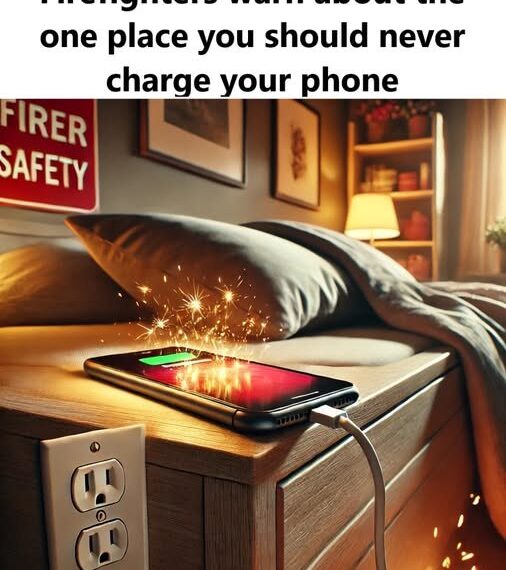- Nightstands and Bedside Tables: Many plug in their phones before sleeping to have a fully charged device in the morning.
- Kitchen Counters: A popular spot, especially while cooking or working at home.
- Office Desks: Keeping your phone charged during work hours is essential for many.
- Public Charging Stations: Airports, cafes, and malls often offer USB charging points.
- Cars: Charging via USB or cigarette lighter adapters on the go.
While these are common and generally safe, the safety largely depends on:
- The quality of charging equipment — using genuine chargers and cables is crucial.
- The device condition — damaged batteries or phones increase risk.
- Environmental factors — cluttered spaces with flammable items or poor airflow can exacerbate heating problems.
The One Place You Should NEVER Charge Your Phone: Under a Pillow or on a Bed
Firefighters and safety experts unanimously warn against charging your phone in bed — especially under your pillow.
Why is this such a big deal?
- Heat Trap: Pillows, blankets, and mattresses are made of materials that easily trap heat. When your phone charges, the battery generates warmth that needs to dissipate. Under a pillow, that heat builds up quickly.
- Flammable Materials: Bedding is highly flammable. Overheated phones can ignite these materials, resulting in dangerous fires.
- Prolonged Charging: Many people charge overnight, leaving their phones plugged in for 7-8 hours or more. This long exposure to heat in an enclosed space compounds the risk.
- Common Among Young Users: Teenagers and young adults frequently charge phones in bed while sleeping, often falling asleep with the device under the pillow or beside them, increasing vulnerability.
Firefighters’ Insights and Warnings
Fire departments nationwide have reported an increase in fire incidents linked to smartphone charging habits. Many of these fires start in bedrooms, caused by phones overheating on beds or nightstands cluttered with flammable items.
Key Safety Tips from Firefighters:
- Always charge on a hard, flat surface like a desk or nightstand.
- Keep the charging area clear of bedding, pillows, papers, and curtains.
- Avoid charging phones under blankets or pillows, even for short naps.
- Use only manufacturer-approved chargers and cables. Cheap or counterfeit products may lack safety features.
- Unplug devices once fully charged or use smart chargers that automatically stop charging to prevent overcharging.
- Inspect your charging cables and phone regularly for signs of damage (fraying cords, swollen batteries).
- Do not leave phones charging unattended for long periods.
Extra Steps to Keep Your Phone Charging Safely
Beyond avoiding risky locations, here are some additional best practices:
1. Avoid Overnight Charging If Possible
While many of us plug in our phones before sleep out of habit, leaving them connected for hours after full charge can stress the battery. Newer smartphones do have built-in safeguards, but it’s safer to unplug once your phone hits 100%.
2. Don’t Use Your Phone While Charging
Using your phone during charging — especially playing games or streaming videos — generates additional heat. This can overheat your phone faster and reduce battery life.
3. Keep Your Phone Updated
Software updates often include battery management improvements and safety fixes, so keep your phone’s operating system current.
4. Avoid Charging in High-Temperature Environments
Charging your phone inside a hot car or near heat sources can increase overheating risk. If your phone feels excessively hot during charging, unplug it immediately.
5. Remove Phone Cases While Charging
Some thick or insulated cases trap heat. Removing the case while charging can help your phone cool better.
What To Do If Your Phone Overheats While Charging
If you notice your phone getting too hot:
- Unplug it immediately.
- Remove the case.
- Move it to a cooler, well-ventilated area.
- Avoid using it until it cools down.
- If overheating continues, have the battery inspected or replaced by a professional.
Signs Your Phone or Charger Might Be Unsafe
- The charger or cable feels hot to the touch.
- Visible fraying or damage to cords.
- Your phone’s battery swells or the back panel bulges.
- Sudden shutdowns or erratic charging behavior.
- Burning smell or unusual noises from your device.
If you experience any of these, stop using the charger or phone immediately and get professional help.
Why Using Certified Chargers Matters
Cheap knock-off chargers are tempting, but they often lack built-in safety features like surge protection and temperature control. Using uncertified accessories can cause voltage spikes, battery damage, or electrical shorts. Stick to original equipment manufacturer (OEM) chargers or reputable third-party brands certified by your phone’s manufacturer.
Conclusion: Small Habits Can Prevent Big Dangers
The convenience of smartphone charging comes with hidden risks that are easy to overlook. A simple habit like charging your phone under a pillow or on a cluttered bed can turn deadly. Firefighters’ warnings are clear: always charge your phone in a safe, ventilated spot away from flammable materials.
By following common-sense guidelines — using quality chargers, avoiding risky spots, and paying attention to your phone’s temperature — you protect not only your device but your home and loved ones.
Next time you plug in your phone, think twice about where you do it. Your safety is worth it.
Have you ever charged your phone in bed or noticed it getting hot? Share your experience in the comments!
And please, share this article with friends and family — it could save lives.





